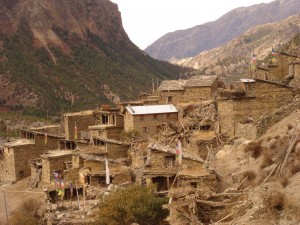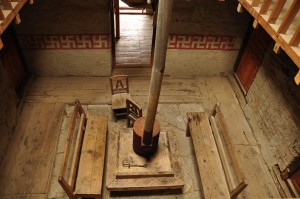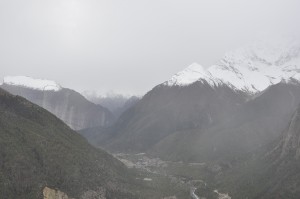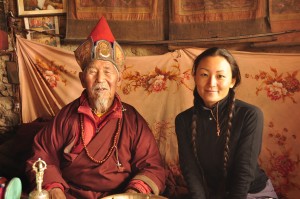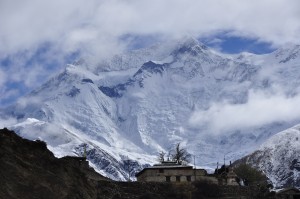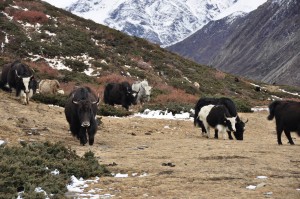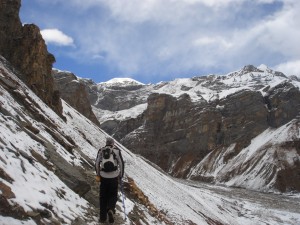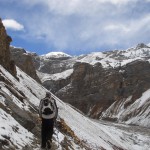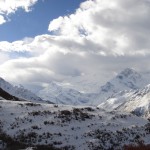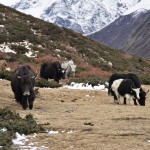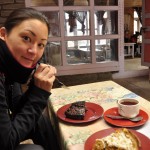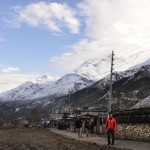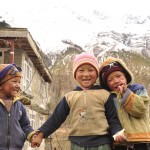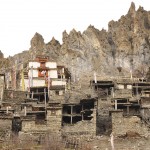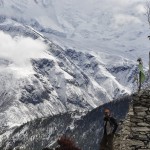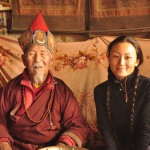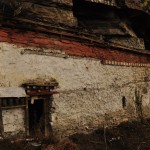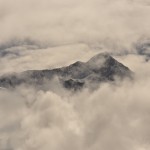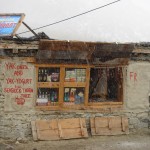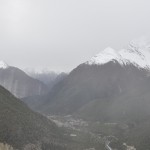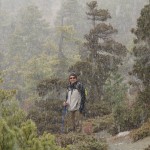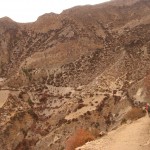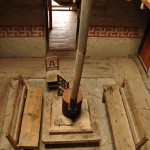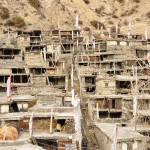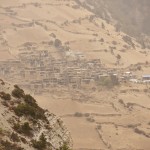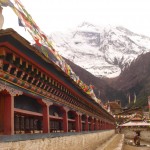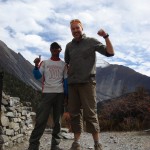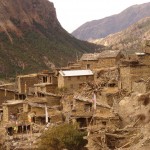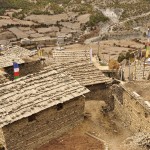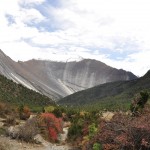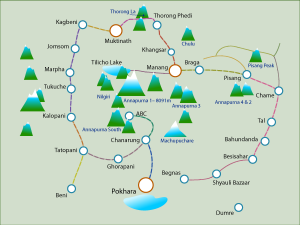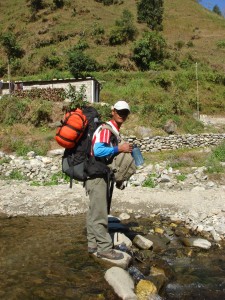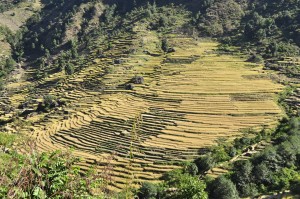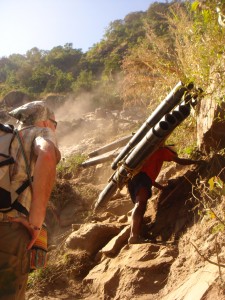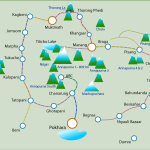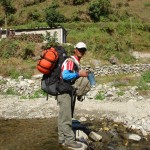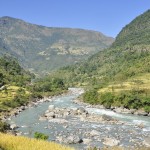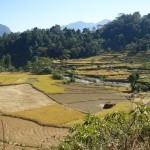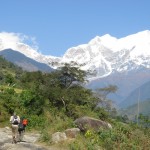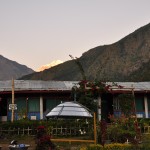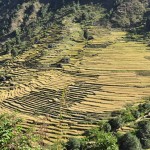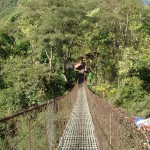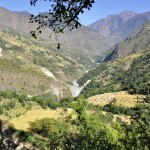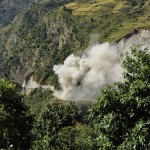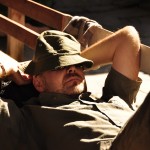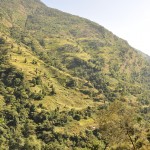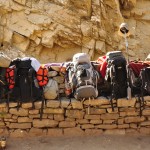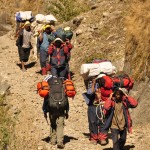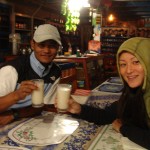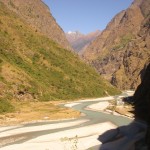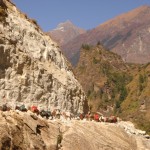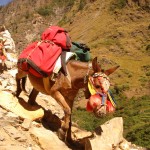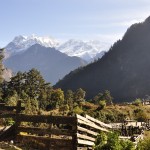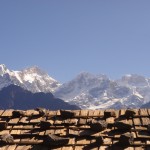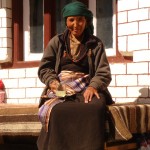Day 5 – Chame to Gyaru (8 hrs trekking, 19 km, 1,020m rise)
After an early start, the morning was spent steadily climbing to higher altitudes, through pine forests and expansive valleys while the Marsyandi river rapids continued to snake far below. The Annapurna snow peaks now dominate the horizon and each new bend in the path or crest in the valley, yields increasingly more resplendent views and angles. We pass through a ruined village, remnants of a former Tibetan Khampa (warrior) camp from the days of armed Tibetan resistance to the Chinese, now little more than shelter to passing porters. The villages now featured large Mani’s, rows of Tibetan prayer wheels, at both their entrance and exits and we could increasingly frequently spy Gompa’s (Tibetan Monasteries) and prayer flags ensconced in the clutches of remote clifftops.
After a few hours, a huge granite wall appears and dominates a large portion of the mornings trekking, the sheer face seems to ascend perfectly upwards and Karna reveals this is a holy site to many of the local Gurungs. Named ‘Paungi Dandi’ or ‘gateway to heaven’, it is believed to be where the dead ascend to heaven. Shamans hold rituals at the base for the deceased and the trail is littered by rocks arranged in neat pyramids and silks scarves tied around bushes and pines – prayers and offerings to the departed.
Continuing uphill, from mid morning the road divides into ‘Upper and Lower Pisang’ routes and we break from the main path to take the higher road. While considerably more challenging, we have read that this is the more spectacular view and experience, the villages more interesting and untouched – it will also be our first taste of higher altitudes and give us a good chance at some acclimatization. Immediately the change is obvious and we have the road to ourselves, blessedly free from other trekkers for seemingly the first time – our imaginations are suddenly sparked and free to roam unchecked. The river drops away to the floor of the valley and we rise up the valley wall. After a tough few hours climbing the thin, winding goat-track path, we reach the village of Upper Pisang, a rocky almost medieval town built into the mountainside and watched over by a large Gompa above. The surrounding land here is above the tree-line and brown and barren. Horses, goats and cows roam fields littered with round stones and bordered in turn by metre high stone walls, on entering the village we sight our first yak seated calmly in a straw covered courtyard. It looks a more desperate existence here, the Tibetan people are browner, tougher, more hardened – you can tell that the wind howls through here. The village itself is fascinating; the stoned paved alleys that link the town, reveal a complex warren of stone houses that fuse stables, living quarters and wood storage into a 3d labyrnth up the hill. Many places seem abandoned.
We pause for lunch to take in this new environment, our original objective and perhaps inspired decide to forge onto the next town. The trail continues softly along the valley wall for a while, ducking in and out of scattered pines and a beautiful, clear aqua lake. Then suddenly we are faced with a huge swollen incline crested by a Gompa. Depressingly we see a path snaking its way directly up the slope and realize we may have been too ambitious here. For 2 hours we slowly zig zag up the mountains, a 500m rise and by far our hardest climb so far. For company, we are egged on by a team of porters, good naturedly chasing their patrons up the slope into the setting sun. Every 50m or so, we are forced to stop and catch our breath, our first taste of altitude and far from a pleasant one.
Eventually though and truly exhausted we reach Gyaru, another medieval stone town and at 3,700m, far higher than I have ever been in my life. At the top we are greeted by stunning vista’s of the mountains, a definite fatigue reliever. The nearest guesthouse, the Yakru Mount View (their are only 2) is a 2 storey construction, built around a hollow central lounge room with fireplace – you can tell that this is essentially efficient and we secure a nice room overlooking the mountains. The young manager is playing some impressively funky music which helps to keep us warm in the fading light. It quickly becomes freezing and we settle in with an older english trekker around the fire, happily immersed in intimate conversation, until the embers start to fade.
Day 6 – Gyaru to Manang (6 hrs trekking, 15 km, 190m fall)
After a sleepless night, a common symptom of altitude, we wake up to find the weather has closed in and the brilliant surrounding vista of yesterday afternoon has been with-held ominously from view. After a breakfast of Tibetan bread, (kind of like dampa, fried like a pancake and my new staple) we head outside and feel the first faint tickles of snowfall. For the first couple of hours we trek in the light snow along a thin, winding trail through pines and bushes regaled in the full spectrum of Autumns shades. Despite the weather and clouds covering the peaks, the views remain breath-taking and we are happily entertained. Walking comfortably along flat tracks, after the previous days climb, we reach Ngawal, another medieval stone town, set into the barren hill side and beset with the usual prayer flags and mani’s.
After tea in Ngawal, the snow gets heavier and more serious, the path on the stoney, thinly forrested higher altitude is very exposed and the constant snow means we are soon wet and freezing. We accelerate and button down for the long 3 hour trek to Manang; the walking turns into a slow endless and relentless drive to get there, Megumi is noticeably fading just as we reach town. We arrive to find that with the weather, the town is backed up with other trekkers, Manang is a reasonably sized village and normally somewhere that trekkers stay a couple of days in order to help acclimitization. On this occasion, the poor weather has mean’t that no-one has moved on and we are forced to take the only room we can. A wooden hut, down a muddy path at the back of a hotel. We take dinner early and retire exhausted and freezing, as the snow continues to fall steadily outside.
Day 7 – Around Manang
It is another sleepless night and I hope that I can acclimatise soon, you seem to dream more at altitude as well I think, which takes some getting used to. Outside everything is white and covered with snow, but there is blue sky about and the weather is clearing. We have decided to take a rest day as well and use the time to acclimatize by exploring some of the surrounding area.
After a solid breakfast and blessedly free of packs, we embark on a climb up to Prakeen Gompa, situated high on the cliff-face above Manang. As we climb, the weather clears and we are gifted with a constantly shifting series of glimpses at the stunning peaks that surround us in all directions. It takes about an hour and a half to scramble up to the vertical path to the Gompa- as we get closer to the top, we are again forced to stop every few metres to get our breath and stay thumping hearts as the higher altitude takes its toll. One guidebook says this is 4,500 metres, another 3,900 – Karna thinks its the former – even he is blowing hard .
At the top, we stop to catch our breath and then enter the Gompa. A 93 year old Tibetan Lama and his wife live here, the Lama is famed for providing blessings to trekkers who are crossing the Thorung La pass for a small donation which is why we are here. He greets us in a grimy temple cut into the cliff wall and then individually performs the blessing. First by giving us some medicine for the pass – small black seeds that we wash down with a special oil. He then places a braided necklace around our necks, to act as a charm for the crossing; and finally uses a Tibetan prayer within its protective wooden case to anoint our heads. Afterwards we are served tea and chat with him amicably. He, like everyone we seem to meet here, is fascinated by Megumi – with her nose ring and slightly mongolian cheekbones /nose, she looks convincingly Nepali or Tibetan; but her clothes just don’t fit. Megumi buys some prayer beads from him and he tells us he has lived in this cave for more than 40 years.
Feeling considerably energised and empowered by this experience, we depart the Gompa and charge back down the mountainside, shimmying down cliff faces and goat tracks across to a couple of other hilltop Gompa’s on our way to the neighbouring town of Braga. The views were breathtaking, the peaks continuing their games of hide and seek with the clouds, so that full paroramic was never quite in view. There is something about the mountains here that makes the spirits soar, I can see why the Tibetans dedicate themselves so wholly and successfully to pursuits of the spirit, the air tingles with a heightened consciousness and self clarity here, amplified a hundredfold by the vastness, solitude and immensity of nature.
After exploring the clifftown of Braga, we returned to Manang blending back into the menagerie of trekkers acclimitizing. There are more and more familiar faces now – a strange, eclectic mix and not quite the band of soulsearchers I had envisioned; at times, the place has more the feel of a European ski resort. Tomorrow, we make for Letdar, some 4100 metres and the the first real test for altitude sickness and although we climbed higher than that today, above 3,500metres you can only rise by 300m per day in order to allow your body to acclimitize. Should be interesting.
Day 8 – Manang to Letdar (3 hr trek, 10km, 660m rise)
We rise at 6am to have breakfast and set off by 7am. We are determined to beat the crowd and ensure a decent place to sleep at the next locale. The trail rises slowly and the altitude ensures we are constantly out of breath, it is very slow going. Megumi in particularly is really suffering and unable to breath – its her birthday today, a little unplanned and hard to make much of a fuss given where we are. The morning starts out cold and drizzling but slowly clears and the mountain views steadily improve. After a few hours, we reach Yak Kharaka and cross the snowline. The hills are covered with Yaks grazing here, it is where all the locals in the area put their yaks out to pasture.
An hour further down the track we reach Letdar, there are 3 hotels and little else. These aclimitizations villages seem to becoming a littlew more desperate and isolated the higher we get. The first is already full care of a tour group and and at the second we are shown a twin room in a mud cave that has more akin with a stables, not quite what Megumi is up for on her birthday. Despite her fatigue and willingness for whatever, I stubbornly head back down the hill fortunately finding a Sunny room at our 3rd and last option.
Later in the afternoon, we walk back down past the yak mustering to Yak Karkha to give Megumi a reprieve from her fatigue (a major sign of AMS). There is a lodge here that is also famous for having some of the best chocolate cake on the circuit, so she is able to dine out a little and considerably raise her spirits. Not much of a birthday this and I didn’t even bring a present along, but I do have other plans further along!
We have some Diamox with dinner and bond over the cold, with a couple from Slovakia and a Korean trekker. Sleeping is a nightmare and the Diamox ensures we have to get up and brave the -5 / 10 degree weather every hour to get to the toilet.
Day 9 – Letdar to Thorung Pedi (3 hr trek, 5km, 400m rise)
Megumi wakes up feeling much better in the morning and we stomp the couple of hours along the rocky path in the mountainside to Thorung Pedi in very good time. The path is a slow climb, but not challenging with fantastic views back to Annapurna 2 and Gangapurna. We spend some time behind a trek group of some 15 Germans which makes us feel a lot better about ourselves and also pass see a huge group of Musk deer grazing.
On reaching Thorung Pedi, we fiork out an extra 200 RP for a room with an attached bathroom – quaking at the idea of venturing outdoors all night to the alternative. After a fortifying lunch of soup and baked potato’s we trek the hour and a half up to the high camp (4,850m) for some more acclimitization practice. It is an arduous climb and we can barely make 20 metres at a time without stopping short of breath. The steep snow and ice covered path is also quite hazardous and a daunting prospect for tomorrow. We stop at the teahouse and engage with our former english acquaintence and another older Irish chap before heading back down the hill.
Tomorrow is intimidating and there is little prospect of sleep. We need to trek for 9-10 hours tomorrow, the first 5 hours will be a tough, freezing high altitude climb to the pass of Thorung La, followed by a nightmare, 4 hour descent. All the conversations at the dinner table are quite restrained and sober as a result – everyone is feeling the effects of the altitide and focused on the big day ahead. It is freezing cold and we decide to retreat to our sleeping bags relatively early. Kana also manages to steal a few blankets for us. Our -20 degree rating on the sleeping bags has been sorely tested and come up short the last 2 nights.
